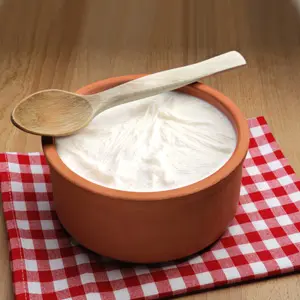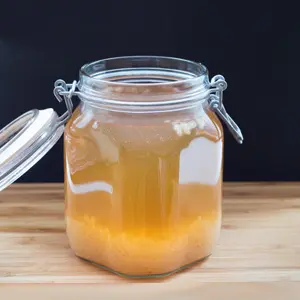Yogurt: Is This Creamy Treat the Key to Your Pet's Gut Health?
Your pet's digestive tract is the largest immune organ in the body, and feeding them this creamy treat may help keep it in top shape.

STORY AT-A-GLANCE
- One of the most popular dietary sources of probiotics is plain yogurt, and the good news is it can be a great pet treat or part of your pet's nutritionally balanced, species-appropriate homemade diet
- Probiotics have been found to help promote gastrointestinal (GI) health and protect against health problems by rebalancing the ratio of good-to-bad bacteria in the gut
- Research shows probiotics improve the antioxidant profile and metabolic response in dogs
- Yogurt is a rich source of protein. Greek yogurt, in particular, provides the highest amount of this macronutrient, containing about 1.525 grams per tablespoon serving
- Kefir is another cultured dairy option that’s been found to help improve lactose digestion, strengthen the immune system and protect against a number of conditions
Editor's Note: This article is a reprint. It was originally published September 20, 2020.
Many pet owners are becoming aware of the importance of promoting optimal gut health in the overall well-being of their animal companions. While this can be achieved with the help of high-quality pet probiotic supplements that are widely available, it's still a good idea to let your pet acquire healthy gut bacteria from foods.
One of the best and most popular dietary sources of probiotics is plain yogurt, and the good news is it can be a great pet treat or part of your pet's nutritionally balanced, species-appropriate homemade diet. Read on to learn more about yogurt and its health benefits to your furry friend.
Did You Know?

The term “yogurt” came from the Turkish word “yoğurmak,” which means to thicken. Yogurt has been a part of the human diet for thousands of years, with references to its health benefits dating back to 6000 BC in Indian Ayurvedic medicinal texts.1
More Facts About Yogurt
Historical accounts suggest that yogurt was first discovered by nomadic herdsmen who used pouches made from animal skin to carry the milk they harvested from their cattle. The pouches, which had naturally occurring enzymes, were carried close to the body, causing the milk inside to ferment.2 Turkish immigrants brought yogurt to the U.S. in the 1700s, but it wasn’t until the 1950s that it became widespread, as the awareness of consuming organic and fermented foods was on the rise.3
Today, yogurt is made by heating milk to break down the fats and then adding a culture starter, which is the source of good bacteria. It’s incubated for six to eight hours, or longer, to allow the fats to regroup with the good bacteria, which convert the lactose in milk into lactic acid, giving yogurt its distinct thick texture and tart flavor.4 The fermentation process involved in making yogurt unlocks the nutrients and makes them easy to absorb. Some of the good bacteria that your pet can obtain from yogurt include:5,6
- Lactobacillus bulgaricus
- Streptococcus thermophilus
- Lactobacillus acidophilus
- Lactobacillus casei
- Bifidobacterium
- Lactobacillus reuteri
The Benefits of Probiotics Go Beyond the GI Tract
Having a healthy gut is important, as it contributes to a number of biological processes in your pet’s body, including nutrient absorption, immune system modulation and vitamin synthesis. If your pet has an imbalanced gut due to poor diet, antibiotics, stress or toxic household products, they’re at higher risk of health issues that affect more than just the gastrointestinal (GI) tract.7
Probiotics have been found to protect against these health issues by rebalancing the ratio of good-to-bad gut bacteria. According to an Animal Nutrition and Feed Technology study, probiotics may help in “improving the hind gut health, antioxidant and metabolic response in dogs.”8
Research conducted on felines also showed favorable results. A study in Veterinary Record Open found that mixing probiotics in the diet of adult cats helped improve their fecal quality and gut health,9 while another article published in the American Journal of Veterinary Research highlighted probiotics’ systemic and immunomodulatory effects.10
Aside from promoting optimal GI health, research suggests that probiotics may be beneficial to pet allergies as well, as they exert anti-inflammatory properties.11 Probiotics have also been found to help reduce serum cholesterol levels in dogs with gastrointestinal problems12 and reduce aggressive and phobic behavioral disorders, which are linked to dysbiosis in the gut microbiome.13
How Healthy Fats Benefit Your Pet’s Body
“Yogurt contains conjugated linoleic acid (CLA), a functional fatty acid that's known to have many potential health benefits.”
The fatty acid content of yogurt depends on the milk used to make it. According to a study published in the journal Food Chemistry, yogurt made from full-fat milk contains higher amounts of CLA on a lipid basis compared to that made from low-fat milk.14
An article in Anticancer Research evaluated the effects of CLA on mammary cancer cells and found that it may help lead to better prognosis by suppressing malignant cancer cell growth and exerting “inhibitory effects on tumor-associated non-malignant mammary cells.”15
Studies have also highlighted the potential use of CLA as an antiobesity agent for both animals and humans because of its ability to inhibit body fat accumulation and weight gain.16,17
This Macronutrient Is Crucial to Cells and Tissues
Yogurt is a rich source of protein. Greek yogurt provides the highest amount of this macronutrient, containing about 1.525 grams per tablespoon serving.18 Its protein content is even higher than that of milk.19
Protein is an important macronutrient that acts as a structural element for your pet’s cells and tissues, including their skin, fur, muscles and organs.20 It also plays a role in carrying oxygen in the blood, regulating chemical changes, transporting fat and cholesterol and synthesizing digestive enzymes, among others.21 Inadequate consumption of protein has been found to deplete lean body mass in dogs, increasing their risk of early mortality.22
Yogurt Is a Good Source of Calcium, Too
A tablespoon serving of plain yogurt contains around 17 milligrams of calcium.23 According to a study in the journal Veterinary Clinics of North America, calcium interplays with phosphorus and vitamin D to maintain normal cell, tissue and organ function. The researchers also highlighted that it’s “nutritionally important to meet the physiologic requirements” for calcium, as it contributes to bone metabolism and renal health.24
Treat Your Fur Buddy to These Healthy Yogurt Snacks
If you’re looking for a fun way to incorporate yogurt into your pet’s diet rather than just giving them a dollop as is, then try making the simple and tasty recipes below. Remember to control the amount you give to your pet, as healthy treats like this should make up less than 10% of their daily caloric intake.
Layered Doggie Ice Cream Bites
Ingredients:
- 1 cup fruit of your choice
- Homemade yogurt
- Coconut oil, melted into liquid
Procedure:
- Blend the fruit until it turns into a puree.
- Place a tablespoon of yogurt in each of the freezer trays. Place in the fridge and let freeze.
- Add the puree and then freeze again.
- Add a layer of coconut oil and then freeze again.
- Once all layers have frozen, pop out each of the doggie bites. Let your pet enjoy!
Green Chicken Crumpets
Ingredients:
- 1 cup ground chicken
- 1/4 cup plain organic yogurt
- 1/2 cup freshly chopped basil
- 1 tablespoon hemp protein powder
Procedure:
- Heat oven to 200 degrees Fahrenheit (93 degrees Celsius).
- Combine all ingredients in a mixing bowl.
- Drop into bite-sized morsels on a greased cookie sheet.
- Bake for 30 to 35 minutes, or until light brown.
Another Excellent Cultured Dairy Option — Kefir
While most people are likely familiar with yogurt and what it looks and tastes like, kefir may not be as popular. It’s often described as a drinkable yogurt and is even touted as the “21st century yogurt,” but they’re actually two different dairy products.25
Kefir is made by adding kefir grains — tiny, cauliflower-like cell structures that carry the bacteria and yeast — to milk and leaving it to ferment for 24 hours. The grains are then removed before the kefir is consumed, so they can be reused.26,27 It tastes similar to yogurt, although a little tangier.28 Some of the probiotics and yeasts found in kefir include:29
- Lactobacillus paracasei
- Lactobacillus acidophilus
- Lactobacillus delbrueckii ssp. bulgaricus
- Lactobacillus plantarum
- L. kefiranofaciens
- Lactobacillus kefiri
- Geotrichum candidum
- Saccharomyces cerevisiae
- S. unisporus
- Candida kefyr
- Kluyveromyces marxianus ssp. marxianus
Kefir Fun Facts

There’s another type of kefir called water kefir, which is made using a different type of kefir grains and sugar, resulting in a fizzy liquid. If your pet cannot tolerate any dairy, water kefir can be a good dairy-free, probiotic-rich alternative.30
How Can Your Pet Benefit from Kefir?
As with yogurt, kefir can be given to your pet as a treat or as part of their nutritionally balanced, species-appropriate diet. Studies have shown that kefir has “antimicrobial, antitumor, anticarcinogenic and immunomodulatory activity.” It’s also been found to help improve lactose digestion, strengthen the immune system and provide protection against conditions like allergies, high blood pressure, gastrointestinal problems and ischemic heart disease.31
One study published in the Journal of Dairy Science examined how effective kefir is at modulating the intestinal microbiota of dogs. There were six adult dogs involved in the study, each fed kefir for two weeks. The researchers observed that kefir consumption led to “successfully modified” microbiota and concluded that kefir could be “developed as a novel probiotic food supplement for dogs to improve the quality of life of dogs.”32
Healthy Kefir Treats You Should Try Making for Your Pet
If you’ve decided to add kefir to your pet’s diet, introduce it to them in a way they’ll surely enjoy through the healthy recipes below. As with the yogurt snacks, limit the amount of these treats to less than 10% of your pet’s daily caloric intake.
Banana Nut Biscotti
Ingredients:
- 2 overripe bananas
- 1/4 cup plain kefir
- 1 1/2 cups almond flour
Procedure:
- Blend all ingredients together, and then pour into a greased 5x7-inch mini loaf pan.
- Bake at 200 degrees Fahrenheit for one hour and 40 minutes. Once done, remove from oven and let cool for 20 minutes. Flip onto a cutting board and slice into 1/2-inch strips.
- Bake the strips again at 200 degrees Fahrenheit for 1 hour and 15 minutes, or until hard. Remove from oven and let cool before giving to your pets.
Low-Fat Freeze Pops for Pups (Best Served During Summer)
Ingredients:
- 3 cups fat-free organic broth (chicken, beef or veggie)
- 1/4 cup plain, organic kefir
- 1 jar organic meat or veggie baby food (make sure that it has no onions)
Procedure:
- Add all the ingredients to a blender and blend on low until smooth, for about 30 seconds.
- Pour the mixture into ice cube trays and freeze.
Where Did Yogurt and Kefir Come From?

Yogurt is believed to have originated from Central Asia and the Middle East,33 while kefir was originally from the Caucasus mountains of Russia.34

How to Choose the Best Yogurt and Kefir for Your Pet
Whether you’ve decided to add yogurt or kefir (or both) to your pet’s diet, make sure to choose the plain variety. The flavored yogurt and kefir commonly seen in supermarkets contain sweeteners that can cause health problems for your animal companion. You should also choose a product that offers higher amounts of probiotic strains. For yogurt, the Greek-style variant is good for pets as it has more protein and good bacteria. If you buy plain yogurt or kefir, choose organic, as it isn’t made with factory-farmed milk, which is healthier.
Better yet, make your own yogurt and kefir using high-quality raw grass fed milk, preferably the whole, full-fat variant. By making your own yogurt and kefir, you can ensure that you're feeding your pet a product that truly contains beneficial bacteria and is not loaded with sugar and other additives.
Check out Dr. Mercola’s healthy yogurt recipe to find out how to make homemade yogurt. As for kefir, the fermentation process is simple and straightforward — you just have to purchase high-quality kefir grains from a health food store or online. If your pet is dairy-sensitive, using coconut kefir is an excellent alternative.
Sources and References
- 1 Nutr Rev. 2015 Aug;73 Suppl 1:4-7
- 2 Harvard School of Public Health, Yogurt
- 3 Dairy Farmers of Canada, All About Yogurt
- 4 Washington State University Extension, Yogurt Made Simple
- 5 Journal of Dairy Science. Volume 97, Issue 5, May 2014, Pages 2578-2590
- 6 Int J Food Microbiol. 2011 Oct 3;149(3):194-208
- 7 University of Illinois, February 2013
- 8 Animal Nutrition and Feed Technology. 2016;16(2):251-270
- 9 Vet Rec Open. 2019 Dec 20;6(1):e000368
- 10 Am J Vet Res. 2006 Jun;67(6):1005-12
- 11 Vet Immunol Immunopathol. 2012 Apr 15;146(2):185-9
- 12 Folia Microbiol (Praha). 2004;49(2):203-7
- 13 Heliyon. 2020 Jan; 6(1): e03311, Discussion
- 14 Food Chem. 2012 Oct 15;134(4):1839-46
- 15 Anticancer Res. Mar-Apr 2006;26(2A):889-98
- 16 J Lipid Res. 2003 Dec;44(12):2234-41
- 17 The Journal of Nutrition, Volume 136, Issue 7, 1 July 2006, Pages 1940S–1946S, Dietary Management
- 18,23 USDA FoodData Central, Yogurt, Greek, NS as to type of milk, plain
- 19 Front Nutr. 2019; 6: 55. Abstract
- 20 The Weston A. Price Foundation, October 4, 2011
- 21 StatPearls [Internet], Physiology, Proteins, November 14, 2022
- 22 Top Companion Anim Med. 2008 Aug;23(3):154-7
- 24 Vet Clin North Am Small Anim Pract. 2021 May;51(3):623-634
- 25 Braz J Microbiol. 2013; 44(2): 341–349, Abstract
- 26 The Kitchn, September 10, 2023
- 27 Eating Well, February 19, 2020
- 28 The Dairy Alliance, March 5, 2021
- 29 Braz J Microbiol. 2013; 44(2): 341–349, Kefir Bacteria
- 30 Mashed, January 31, 2023
- 31 Braz J Microbiol. 2013; 44(2): 341–349, Therapeutic Aspects
- 32 Journal of Dairy Science Volume 102, Issue 5, May 2019, Pages 3903-3911
- 33 BBC, January 12, 2018
- 34 American Dairy Association, August 28, 2023











